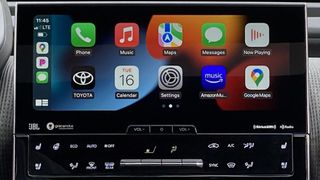We used Toyota's new infotainment system in the bZ4X and it's a huge improvement
Toyota's updated infotainment system is much better

Late last year, we got the chance to see – but not drive – Toyota's new bZ4X battery-electric crossover in person. We also took the upcoming 2022 Tundra hybrid for a brief spin.
What do these two vehicles have in common? Both feature Toyota's new infotainment system, which is also found in the 2022 Lexus NX. Considering Toyota's current infotainment system dates from the paleolithic era, this is a welcome change.
We sat down with Chris Pedregon, Communications Lead, Connected Technologies for Toyota, who walked us through the bZ4X's infotainment system.
Instead of being spearheaded in Japan, like previous infotainment systems, this new infotainment system was developed entirely in-house by Toyota Motors North America's Connected Technologies group to "exceed customer needs and deliver amazing and personal connected experiences" according to the brand.
Standard on the new bZ4X EV




As a quick refresher, the bZ4X is Toyota's first battery EV since the RAV4 EV compliance car back in 2014. It shares almost its entire design with Subaru's Solterra battery-electric crossover, and represents Toyota's first attempt to take battery EVs seriously after years of betting on hydrogen fuel-cell and plug-in hybrid vehicles.
While the bZ4X is built on a bespoke battery EV platform (e-TNGA), it looks and feels a lot like the RAV4.
In fact Toyota's making sure not to step on the toes of its best-selling ICE crossover, with the 302hp RAV4 Prime plug-in hybrid still being faster, thanks to a 0-60mph sprint in 5.7 seconds.
Get daily insight, inspiration and deals in your inbox
Get the hottest deals available in your inbox plus news, reviews, opinion, analysis and more from the TechRadar team.
The bZ4X will come in two flavors: a 201hp single motor configuration (FWD) with estimated range of 311 miles (500km) and a 215hp dual motor model (AWD) with an estimated range of 286 miles (460km). Neither will reach 60mph in less than 7.5 seconds.
Both versions feature a 72KWh battery and support 150KW DC fast charging. And while the bZ4X's pricing hasn't been finalized yet, it's clearly competing more with VW's entry-level ID.4 than the Ford Mustang Mach-E or Tesla Model Y in terms of specs and performance.
In other words, these are baby steps for Toyota. Our brief time with the bZ4X confirmed that this EV doesn't push the envelope apart from the infotainment system.
Choose your size, all come fully connected



Toyota's new infotainment is built around completely new hardware and software. In the bZ4X, it uses a 12-inch touchscreen, but other display sizes include 8, 10, and 14 inches (Tundra and Lexus NX, depending on trim).
Regardless of display size, you get a bright, high-resolution, glass-bonded, capacitive touchscreen, and the same quick and responsive user interface – thanks to significantly more processing power than before.
While it's unclear what kind of processing hardware Toyota is using here, connectivity is integral to this new infotainment system, with built-in WiFi and 4G support for hotspot functionality and OTA (over-the-air) software updates.
In addition, two phones can be connected via Bluetooth simultaneously, making it easy for the driver and front passenger to seamlessly take calls or play media from their handsets – no switching required.
The home screen has been kicked out
One way this new infotainment system stands out is that it lacks a home screen. Toyota is using a "one step away" approach with a persistent vertical icon bar on the left side of the display.
It lets the user switch between various interface screens, including navigation, media, phone, car, settings, and Apple CarPlay / Android Auto (when available). This, Toyota claims, makes for a simpler and more intuitive user experience.
This new infotainment system also makes ample use of whitespace and large, legible fonts. As such, the user interface feels light and airy, making it more welcoming – though we found the color scheme a little too monochromatic and dull for our tastes.
Then again, Toyota is touting a "voice first" approach here, and believes most users will navigate this new infotainment system using the new "Hey Toyota" intelligent voice assistant.
"Hey Toyota"

First, this new "Hey Toyota" voice assistant is able to understand natural language and context. Second, it uses microphones above each front seat to determine whether the driver or front passenger is speaking.
For example, if you say "hey Toyota, I feel like coffee", you'll get a list of nearby coffee shops to choose from. But if you say "show me the nearest charging station", you'll be offered a single location to navigate to.
In our brief time using the new infotainment system, we found this new voice assistant worked reasonably well, though it's not quite as refined as Siri or Alexa, and definitely not as advanced as Google Assistant.
Basically, it gets the job done, but it's not nearly as sophisticated as the voice assistants we're all familiar with. Still, this intelligent voice assistant is a major upgrade, and one of the better ones we've used in a car to date.
Toyota's new infotainment system also features user profiles which allow you to carry your settings – from preferred media and radio stations to climate settings in some models – across multiple vehicles.
User profiles live in the cloud, and can be paired with individual key fobs or digital (smartphone-based) keys via the Toyota app. You can also login to your user profile using the infotainment system directly.
Plays nice with Google, Apple and Amazon

As we previously mentioned, this new infotainment system was designed from the ground up around connectivity. It uses Google's cloud services for real-time navigation, traffic, and POI (points-of-interest), and includes an offline mode that caches this data in advance in areas of poor connectivity.
It even inherits other features from Google Maps, like two-finger swiping for a 3D view, and ETA sharing via text message.
Other cloud services include Apple Music and Amazon Music, which are both linked to your user profile. Basically, you login to one or both music services inside the Toyota app, which then follow your user profile from vehicle to vehicle – no phone required.
It's a pretty clever setup. Unfortunately, Spotify and YouTube Music are missing here, and it's unclear if Toyota plans to add these music services in the future.
Of course, in addition to Bluetooth connectivity, FM and AM (terrestrial) radio, and SiriusXM (satellite) radio, Toyota's new infotainment system also supports wireless (and wired) Apple CarPlay and Android Auto.
Ultimately, while this new infotainment system isn't breaking any major new ground, it's a huge improvement over Toyota's previous efforts. We're looking forward to spending more time with it when we review the bZ4X.

Myriam Joire (tnkgrl) was born wearing combat boots and holding a keyboard. Moments later she picked up a soldering iron. On weekends, she rally-raced with her father. She's been stomping, typing, hacking, and driving ever since. After spending years being a code-monkey in the video game industry, she joined Engadget as Senior Mobile Editor and later Pebble as Chief Evangelist. Today she hosts the weekly Mobile Tech Podcast, makes videos on YouTube, writes about tech and cars for TechRadar and other major publications, and advises startups on product/media strategy. She's based in San Francisco.